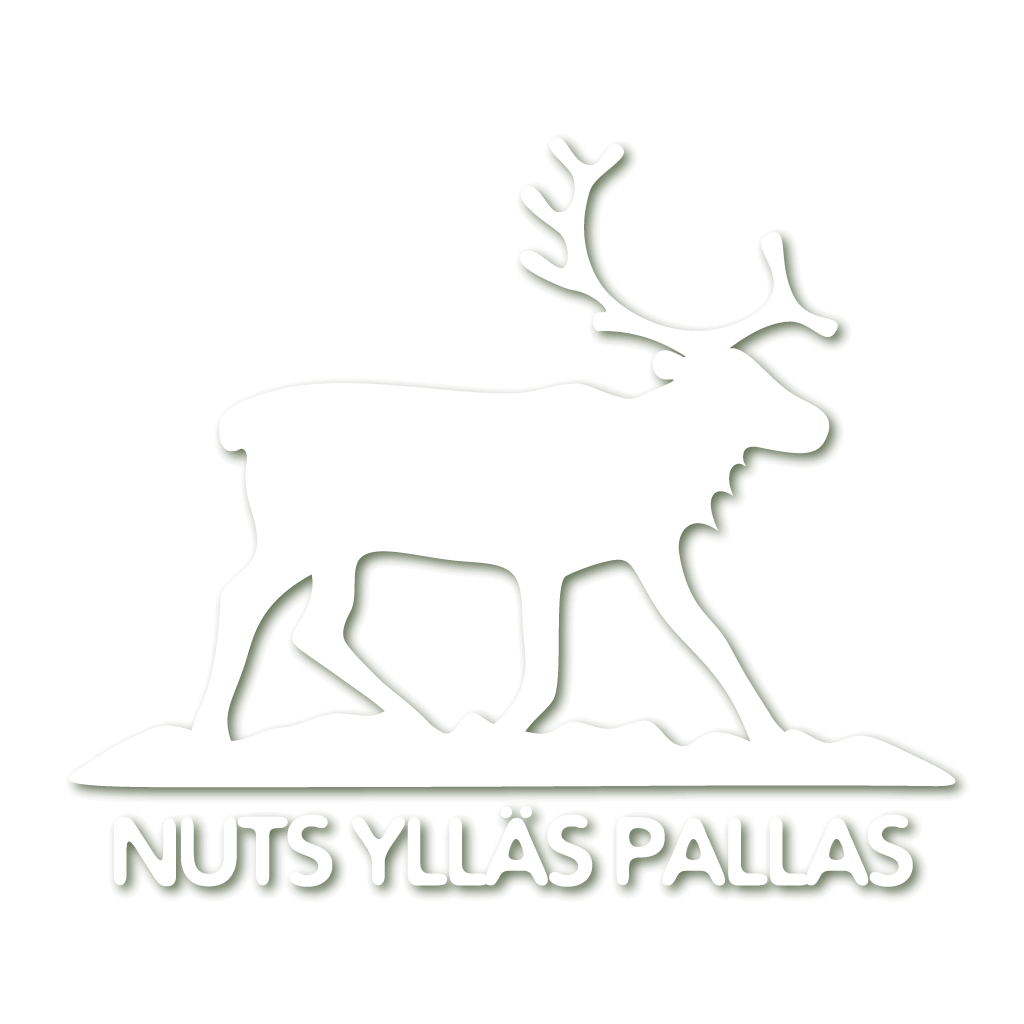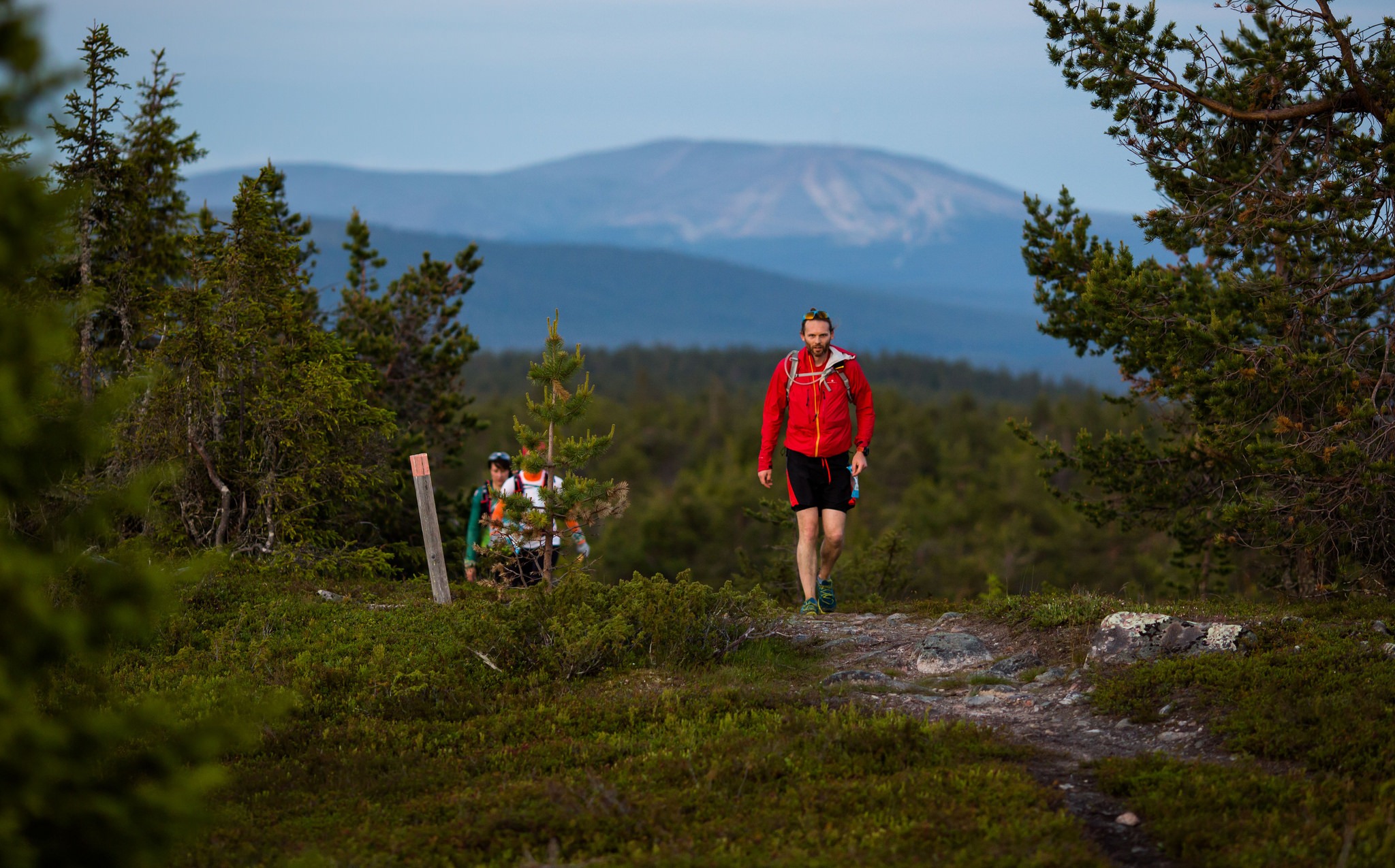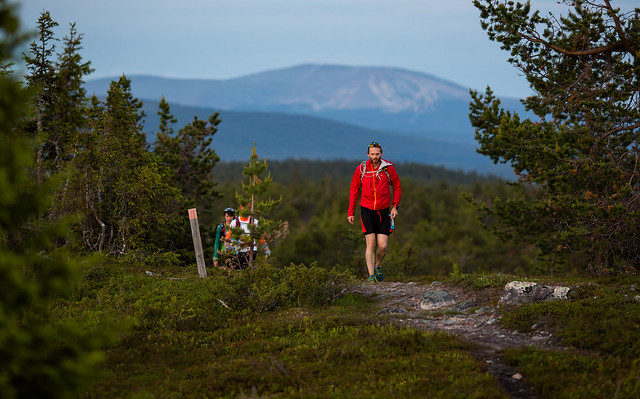(English) NUTS Pallas 2015 review by John Ryan
Above latitude 68
I have always been fascinated with the Arctic Circle and what it is like in the extreme days they experience – from days of no sun to nothing but. Fortunately I got the opportunity to experience this first hand on the Nuts Pallas 125km Ultra in July and find out if my mind would be powered by 24 hour sunlight or exhausted by it.
Before Sunset Photo by Aapo Laiho (link to his great Flicker album of the race)
Getting there
The race is located just inside the Arctic Circle with a number of airports nearby. If you are travelling with others and some support, hiring a car is a great option as the roads are good and not many of them so hard to get lost. I was travelling solo and I found that flying into Kittilla airport and taking a taxi (~€70) to the start line town in Akaslompolo. With a finish point in Hetta there is a bus from Hetta to Kitilla at around 07:30 on the Sunday morning which got me back to the airport hours before my flight – just make sure you finish in time! There are many accommodation options and I stayed in a ski hotel part of the Lapland Hotels in Akaslompolo. Staff were friendly, rooms simple and clean, wifi everywhere and food was excellent.
Day and night difference
Sadly photos can’t be attached here, but what little night time there is, is like sunrise on an overcast day. At no stage did I need a head torch but if the weather turned on you or you get injured and need to signal for help you will find out too late why it is still a requirement!
Race format
Race format is interesting as the start time is midnight and so I had all day Friday to try and sleep, eat and get ready – so instead of a hearty breakfast before the race I had a delicious Reindeer stew with chips!
You can register for the race in race HQ at the finish line in Hetta or at the start line in Akaslompolo. The start line is in the town so you can park close to it and sort out final preparations and cheer on the finishers of the 23 km race evening. There are no public toilets at the start line but there is a bar/restaurant. You can drop your bag at Hetta & the start line and it will be delivered to the mid-point (Pallas Hotel) and the finishing line in Hetta.
The race manual provided is very good and provides a lot of useful information and they also provide GPX files for watches.
Online GPS tracking is provided which is great for those supporting you back home. I didn’t realise that I had to turn it on until half way through the race so mine lasted to the end, unlike others runners whose units died near the end and created a bit of confusion with people calling asking why have you stopped for the last hour!
The race follows paths through the national park and the way finding was very good – I only took a minor wrong turn once in the entire race. Some single file tracks started off the race and this very quickly spread out the group, so within 5-10km you were running in smaller groups of people.
Terrain
Mosquitoes THEY ARE EVERYWHERE!
I thought people were joking, why would they be this far north away from anything edible? For some unknown reason the place is infested with them, you can’t stop for more than 30 seconds before they start swarming around you looking for blood, sit for 10 minutes and they will probably suck you dry – the Piranhas of the North! You really do need to have a good spray with you, I bought some of the local stuff which worked well but as you are sweating a lot you need to keep re-spraying
The First 70km
This was probably the toughest race I have ever done from a technical point of view. The park paths had not been maintained in years, which meant you had to concentrate hard if you were not used to ducking diving weaving around/over/under/through trees, branches, rocks and reindeer! I love running through forests in this kind of conditions – but I have not got the technical ability or able to concentrate for this distance to keep up my target pace. so it was pretty tough going and required much more concentration than more simple trail runs I have done in the past.
In saying that it was beautiful, the place is stunning, remote and raw natural beauty you just don’t get to see very often.
Aid Stations & checkpoints
Checkpoints do not have any aid so you have to plan on getting through these unaided, which with planning was easy to achieve.
Aid stations had at a minimum – chocolates, crisps and water with no toilet facilities.
At all points – the organisers were very friendly and helpful and gave good advice on the terrain ahead.
One thing to note is the location of the checkpoints, in the later stages of the race if you decide to drop out you could be looking at a 10km+ walk to the nearest road where you will be collected – this was helpful as it was sometimes shorted to get to the next checkpoint than drop out so you were more inclined to keep going!
For support crews this makes meeting you at the points very difficult, with patch internet connections you could easily waste up to a 4 hour round trip to make it to a checkpoint only to miss your runner. Most of the earlier checkpoints are easily accessible.
Mid-point
The Mid-point had all of the aid station items + energy drinks, warm drinks, pot noodles and more chocolate include Toblerone bars! I had planned my race around being self-sufficient but the additional hot food was a great help to get me going again and the advice from the crew here was invaluable in understanding the complete change in terrain going forward. This is the one cut-off point in the race which is 15 hours
The last 55km
The mid-point serves as the start line for the Buff 55km run, which sadly I didn’t arrive on time to see start or be able to run with.
On the website this is the one that is featured in the promo video for the races and gives you a good impression of what is ahead – open barren raw beautiful landscape and with the summer sun (after it stopped raining) was a big change from the previous 70km.
The narrow paths turned to open tracks with uneven ground but far easier to maintain a more constant speed. The best thing about this section – no mosquitos due to the exposed nature of the hills and light breeze I didn’t see them again!
The path ~20km from the finish line looking back over the course around 11:30pm
My race
Jouko the race organiser was very helpful with all my queries – as I was going solo with no support crew or people I knew I had a few more questions to make sure I had all the details I needed to plan the run.
Gear
My race equipment of interest to others was the Garmin Fenix 2. The watch had a lot of problems with the route I loaded up and the unit did crash a few times at the start of the race – possibly because of the amount of data a track of 125km has, it was very slow to change screens but after a full restart it did start to work correctly for the remainder of the race.
This is something I have had problems with in the past, but in a recent 100 mile run I just pressed start and let it get started before I started checking maps and different screens – so perhaps it just needs some time to get itself up and running.
The battery lasted 15 hours with smart data recording, after that point I used a small charger and the Garmin cable and that charged it up to the end of the race and the plane home.
Shoes – Inov8 Trailroc 235 zero drop trail shoes. The terrain was very rough and as a lot of my training is on relatively flat surfaces I used Sole Armor to cushion the blows. It worked well in training runs and started well, but the rock protector in my left foot (1/2 a size bigger than my right foot) caused it to go numb and this spread to my lower leg so I had to stop and take it out. Once that was done my foot came back to life and I was able to continue on.
By the end of the race my left foot was more beat up than my right foot so they are a good product – just be sure you have the spare room for them in your shoe before using.
Shoes had good grip, plenty of space for swelling etc. comfortable and more protective than the Vibram 5 Fingers I train in, but for longer runs 170km+ I feel that there isn’t enough protection in them for my soft feet!
Food – I brought as much as I could myself and my go to food for this race was the Trek Wheat & Gluten Free Cocoa & Oat Flapjack and diary free chocolate covered raisins, Body Volt Aquabolt sport drink tablets for minerals and vitamins as well as Sun Warrior soya protein + BCAA amino acid supplements for recovery.
I had a cheat sheet for each stage in the race telling me what I should be eating and when, for the most part it provided a good guide but was never followed properly and by the end of the race I relied more on eating when I started feeling tired or running out of energy.
Recovery times were very fast for this race but I could have taken on iron, cod liver oil and vitamin supplements to aid the recovery as I felt burnt out for 2 weeks post-race.
The technical aspect of the run, meant I couldn’t get into any rhythm along the first section and it frustrated me that I did not have the ability to keep up with the rest of the people, I just wasn’t happy with trying to move faster than I was capable of doing and risk injuring myself so I re-planned to get to the finish before the cut off rather than beat myself up about falling behind my target time.
Thankfully the second half was much better and I was able to keep a constant pace moving forward and running where it was possible, energy levels were dropping at this stage and my pace was low enough for the organisers to get worried and call me to see if I was ok and I was also met by a medical person who quickly realised I was in great shape and was on target to finish a few hours before the cut-off.
At this stage I met another runner who had been slowly catching up to me over the previous few hours. We decided to team up for the remainder of the race and it was great to have someone else to run with and support each other
Day light – I think having done a few ultra’s you start to get used to the night running but the sunset is a clear indicator that a long night is about to start and you may not see the sun again for 10+ hours and with the night the cold and tunnel vision with head torches play tricks with your mind.
On this race it was a strange sensation, you just didn’t really notice the night time creeping up on you and by the time you did it was already 3am.
As the sun is very low in the sky over night the temp does drop significantly and like in Ireland – it was cold between 2-8am and only starting to warm up by 9am so warm layers for the night time are a must as the midnight sun won’t keep you warm – especially if the weather is not as good as we had it this year.
It was great to be able to run throughout the night without a head torch and the midnight sun made it psychologically easier to run through the night and onto the finish line
Finish Line
With a time of 27:50:13 (race cut-off is 30 hours) we ended up being the last people to cross the finish line to a round of applause form the race team and we were treated to the best bowl of soup ever in the hotel. We said our goodnights/ good mornings and I went to bed for few hours only to rise at 06:30 to hobble across the road to the bus back to the airport, sadly missing breakfast with the other runners and race organisers.
After thoughts
Would I do it again – Yes I would do this again is the short answer and I would recommend it as a challenging race to those that like this kind of terrain and the idea of running in such a remote and beautiful part of the world in constant day light
What was helpful – Mosquitoes – yes, I know they were out to kill me, but without them I would be still running it or eaten alive! I couldn’t stop for more than 30 seconds, which meant I had to be quick and not lazy with my water/food/toilet breaks
What wasn’t helpful – I suppose access to the checkpoints for support crew could be an issue for some, if you do drop out it is not a simple case of just hoping in a bus and going back to a warm hotel, but this just adds to the mental difficulty of this event and made it more challenging.








